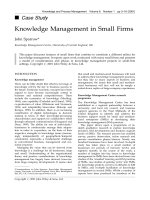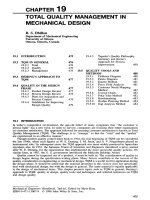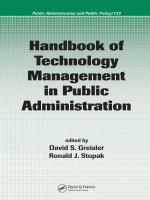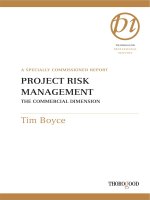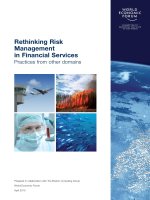Modeling Risk Management in Sustainable Construction docx
Bạn đang xem bản rút gọn của tài liệu. Xem và tải ngay bản đầy đủ của tài liệu tại đây (4.44 MB, 448 trang )
Computational Risk Management
Series Editors
Desheng Dash Wu
David L. Olson
John R. Birge
For further volumes:
/>.
Desheng Dash Wu
Editor
Modeling Risk Management
in Sustainable Construction
Editor
Prof. Desheng Dash Wu
University of Toronto
RiskLab
Toronto, ON M5S 3G3
Canada
ISSN 2191-1436 e-ISSN 2191-1444
ISBN 978-3-642-15242-9 e-ISBN 978-3-642-15243-6
DOI 10.1007/978-3-642-15243-6
Springer Heidelberg Dordrecht London New York
Library of Congress Control Number: 2010938731
# Springer-Verlag Berlin Heidelberg 2011
This work is subject to copyright. All rights are reserved, whether the whole or part of the material is
concerned, specifically the rights of translation, reprinting, reuse of illustrations, recitation, broadcasting,
reproduction on microfilm or in any other way, and storage in data banks. Duplication of this publication
or parts thereof is permitted only under the provisions of the German Copyright Law of September 9,
1965, in its current version, and permission for use must always be obtained from Springer. Violations
are liable to prosecution under the German Copyright Law.
The use of general descriptive names, registered names, trademarks, etc. in this publication does not
imply, even in the absence of a specific statement, that such names are exempt from the relevant
protective laws and regulations and therefore free for general use.
Cover design: eStudio Calamar S.L
Printed on acid-free paper
Springer is part of Springer Science+Business Media (www.springer.com)
Preface
We are living in a risky world, and it is getting riskier and riskier. As one of my
fundamental claims that have been deliver ed to various audience including scho-
lars, practitioners and government officers, first, risk avoidance system in today’s
world is becoming so interconnected; second, it is fully supported by a great of risk
issues that have been addressed in this edited volume. Such risk issues, to name a
few, include typical financial risk such as credit risk and market risk, construction
risk management , supply chain risks, energy risk assessment, environmental risk
analysis, risk management and sustainable development. These risk issues altogeth-
er form a risk checklist that could support my second claim: risk is unavoidable and
business exists to cope with risks in their area of specialization. In William Sharpe’s
CAPM (capital asset pricing model) theory, investments are evaluated in terms of
both risk and return relative to the market as a whole; the riskier a business stock,
the greater profit potential. Thus risk implies opportunity and business exists to seek
such risk-based opportunities.
Prediction of extreme risk events is almost unlikely. In Taleb’s 2007 book titled
“Black swan”, extreme risks are said to be unpredictable like a black swan that lies
beyond the realm of normal expectations. Many firms experienced difficulties from
black swan bubbles. The most spectacular failure in the late twentieth century was
probably that of Long-Term Capital Management [1], but that was only a precursor
to the more comprehensive failure of technology firms during the dot.com bubble
around 2001. The problems of interacting cultures demonstrated risk from terrorism
as well, with numerous terrorist attacks, to include 9/11 in the U.S.
The third claim is that effective risk management needs integration of various
risks facing the organization. National Research Council has two red books on risk
analysis and management: one is from that 1983 titled “Risk Assessment in the
Federal Government: Managing the Process” and the other from 2009 titled “Sci-
ence and Decisions Advancing Risk Assessment”. One of our observations is that
the updated vers ion “Recommends that risk management would become more
integrated with the risk assessment process and focuses attention on improving
the utility of risk assessments to better inform risk management decision-making”
v
[2, 3]. Enterprise risk management has been defined as a process that uses inte-
grated, systematic approaches to manage risks that faces the organization. There-
fore, enterprise risk management has been deemed as an effective risk management
philosophy.
In the past, we have tried to discuss different aspects of risk, to include finance,
information systems, disaster management, and supply chain perspectives [4, 5, 6].
In this edited volume, we present the state-of-the-art views of the perspective of
enterprise risk management, to include frameworks and controls in the ERM
process with respect to supply chains, constructions, and project, energy, environ-
mental and sustainable development risk management.
The bulk of this volume is devoted to pres enting a number of modeling
approaches that have been (or could be) applied to enterprise risk management in
construction from the 1st International Conference on Sustainable Construction
and Risk Management in Chongqing Municipality, P. R China. We include deci-
sion analysis models, auction models to better enable risk managers to trade off
conflicting criteria of importance in their decisions. Monte Carlo simulation models
are the obvious operations research tool appropriate for risk management. Rough
Set and fuzzy set theories are employed. Dynamic models such as dynamic AHP
and Bayesian Networks are used to handle risky project management when achiev-
ing sustainable development purpose. We hope that this book provides some
view of how quantitative models can be applied by more readers faced with
enterprise risk.
Toronto, ON Desheng Dash Wu
July 2010
References
1. Lowenstein, R. (2000). When Genius Failed: The Rise and Fall of Long-Term Capital
Management. New York: Random House.
2. Wu D. and Olson DL. 2009. Introduction to the special section on “optimizing risk manage-
ment: Methods and tools, Human and Ecological Risk Assessment 15(2): 220–226.
3. Wu D. and Johnson B. L. 2010. HERA emphasizing risk management: An editorial, Human and
Ecological Risk Assessment.
4. Olson, D.L. and Wu, D. (2008a). Enterprise Risk Management. Singapore: World Scientific
Publishing Co.
5. Olson, D.L. and Wu, D. (2008b). New Frontiers in Risk Management. Heidelberg: Springer.
6. Olson, D.L. and Wu, D. (2010). Enterprise Risk Management Models. Heidelberg: Springer.
vi Preface
Contents
Part I Enterprise Risk Management in Supply Chains
An Improved Approach for Supplier Selection in Project Material
Bidding Procurement 3
Maozeng Xu, Qiaoyu Chen, and Ligang Cui
Modeling the Out-of-Stock Risk and the EOQ–JIT Cost
Indifference Point 11
Min Wu
A Partner Selection Method Based on Risk Evaluation Using Fuzzy
Soft Set Theory in Supply Chain 19
Zhi Xiao and Weijie Chen
A Quantitative Analysis for Degree of Supplier Involvement
Under Market Uncertainty 29
Zi-jian Zhang and Hua Pan
Part II Enterprise Risk Management in Construction
Dynamic Network Planning Simulation for Scheduling Risk
Analysis Base on Hybrid System 39
Lin Yang, Yanlong Zhao, and Yueyue Chen
Research on the Integrated Risk Management Information
System of Construction Project 47
Yun-li Gao
Sensitivity Analysis for the Relationship Between Toll Rate
and Traffic Volume for Freeway 55
Lian-yu Wei, Yi Cao, and Pei Chen
vii
The Application of Dynamic Priority of AHP on Operation Risk
Assessment of Metro 65
Yunhao Gao, Xiuli Du, and Mingju Zhang
Study on Construction Project Bidding Risk Assessment Model 73
Guofeng Wen and Liwen Chen
Study on Prophase Risk Management in Informatization
of Chinese Construction Enterprises 81
Luo Fu-zhou and Wang La-Yin
Managing Construction Risk in SMEs: The Case of Coastal
Construction 91
Hosein Piranfar
A Study on Management Risk Evaluation System of Large-Scale
Complex Construction Projects 103
Linlin Xie and Yu Yang
Risk-Based Determination of the Prenium Rate of Construction
Work Safety Liability Insurance 113
Hongxia Wang, Gui Ye, and Chuanjing Ju
Part III Enterprise Risk Management in Projects
Multi-criteria Decision Model for BOT Project Selection 123
Min-Ren Yan
Equitable Risk Allocation in Chinese Public–Private Partnership
Power Projects 131
Yongjian Ke, ShouQing Wang, and Albert P.C. Chan
Developing a Construction Safety Management System 139
Jian Zhang and Weng Tat Chan
Analysis of the Equipment’s Maintenance Period Under Different
Operation Stages 145
Jie Chi and Miao Chi
An Evolutionary Game Model for the Risk Management Cooperation
Among the Project Participants 153
Guo-jun Zhang and Yun-li Gao
viii Contents
Application of Industrialized Housing System in China: A Chongqing
Study 161
Yuhong Pan, Francis K.W. Wong, and Eddie C.M. Hui
Part IV Energy Risk Management
The Study on Energy Consumption and Pollutant Emission
of Civil Vehicles in Beijing 171
Li-xiang Zhao, Yi-long Xiong, and Fei Ye
An Investigation of the Coal Demand in China Based on Variable
Weight Combination Forecasting Model 181
Guohao Zhao, Shufen Guo, Jing Shentu, and Yongguang Wang
Investment Cost Analysis for Key Industries of New Energy
Based on Boston Experience Curve 191
Yuanying Chi, Benkun Chi, Xiangyang Li, and Dongxiao Niu
Part V Environmental Risk Management
Green Adaptive Reuse: Issues and Strategies for the Built
Environment 199
Craig Langston
Risk Assessment of Regional Industrial Clusters 211
Yongheng Fang and Zhouping Jia
Subway System Safety Risk Analysis Based on Bayesian Network 219
Ying Lu, Qiming Li, and Jimmie Hinze
Eco-Efficiency Assessment for the Eco-Industrial Park Based
on the Emergy Analysis 229
Hua Shang and Jiabo Li
The Study of Green Risk Assessment for Construction Project
Based on “AHP–FCE” Method 237
Danfeng Xie, Shurong Guo, and Sulei Li
Intensive Land Use Evaluation of Urban Development Zones:
A Case Study of Xi’an National Hi-Tech Industrial Development
Zone in China 245
Wei Xiao and Qingqi Wei
Contents ix
Industrial Planning, Macro-economic Control and Government’s
Role in the Perspective of Economic Crisis 251
Bo Cao and Yang Yu
Evaluation and Simulation for Ecology Risk of Urban Expansion
Based on SERA Model 259
Xiaoxia Shi, Yue Wu, and Han Zhang
Part VI Financial Risk
The Gerber–Shiu Discounted Penalty Function for the Credit Risk
Model with Dependent Rates of Interest 269
Dan Peng and Zaiming Liu
A Risk-Sensitivity Analysis on NPV Model of Investment Projects 277
Xiansheng Qin, Xuyao Ma, and Hongwei Bai
Research on Appraisal of High-Tech Entrepreneurial Risk
Based on Osculating Value Method 283
Yan-Rong Wang and Qiao-Ling Xu
An Approach to Overseas Iron Ore Investment Risk Assessment
Based on Fuzzy Neural Network 293
Li Guo, Caiwu Lu, and Zhen Yang
Analysis on Structure Risk and Its Countermeasures of International
Trade Corridor in Inland China 301
Xiao-dong Xie, Mao-zeng Xu, Shun-yong Li, and Li Huang
Part VII Sustainable Risk Management Tools
Asphalt Pavement Surface Penetrate Rejuvenate Restore
Technology: Application and Evaluation 313
Xiaohong Guo and Bangyin Liu
A Study of Construction Project Conflict Management Based
on Evolutionary Game Theory 321
Jie Ding
Study on the Management Mechanism of Emergency
Telecommunication in China 327
Zhenyu Jin, Xiaoyu Wan, and Xingming Yang
x Contents
Forewarning for Urban Sustainable Development Based
on Fuzzy Matter Element Model: Taking Nan Tong City
for Example 335
Wen-jin Zhang and De-shan Tang
Resident Population Prediction Based on Cohort-Comp onent
Method 343
Biyu Lv, Jiantong Zhang, and Hong He
Dynamic Monitoring of Land Utilization Security of Mining City 351
Jin-sheng Zhou
Risk Assessment of Water Transportation in Three Gorges
Reservoir Through Approaches of System Engineering 363
Dan Zhang, Liwen Huang, and Xiaobiao Fan
Damaged Bridges over Watercourses and Stream Order
Flood Analysis 371
Marek Mihola
Part VIII Enterprise Risk Management Modeling
Understanding Commuters’ Daily Travel Time: Application
of a Hazard-Based Duration Model 379
Zhicai Juan, Jianchuan Xianyu, and Linjie Gao
Influence of Perceived Risk and Service Recovery on On-Line
Shopping: A Dynamic Game of Incomplete Information 387
Yong Fang and Fengming Tao
Traffic Risk Assessment of Freeway On-Ramp and Off-Ramp Areas
Based on Simulation Analysis 395
Ying Yan, Yan-ting Sheng, and Yu-hui Zhang
Probe into the Effectiveness Connotation of Emergency
Telecommunication Plan and Its Assessment Method Under
Unconventional Emergency 407
Xiaoyu Wan, Zhenyu Jin, and Jinying Wei
Risk Assessment of Levee Engineering Based on Triangular
Fuzzy Number and Analytic Network Process and Its Application 415
Feng Li, Zong-Kun Li, and Chuan-Bin Yang
Contents xi
.
Contributors
Hongwei Bai Shaanxi Fast Gear Co., Ltd, Xi’an, People’s Republic of China,
Bo Cao Economics and Management School of Beijing, University of Technology,
Beijing 100124, People’s Republic of China,
Yi Cao College of Civil Engineering, Hebei University of Technology, Beichen
District, Tianjin, People’s Republic of China,
Albert P.C. Chan Department of Building and Real Estate, The Hong Kong
Polytechnic University, Kowloon, Hong Kong, SAR, China,
Weng Tat Chan Department of Civil Engineering, National University of
Singapore, 1 Engineering Drive 2, E1A 07-03 Singapore, 117576, Singapore,
Liwen Chen School of Management, Hebei University of Technology, Tianjin,
People’s Republic of China,
Pei Chen College of Civil Engineering, Hebei University of Technology, Beichen
District, Tianjin, People’s Republic of China,
Qiaoyu Chen School of Management, Chongqing Jiaotong University, Chongqing
400074, People’s Republic of China,
Weijie Chen School of Economics and Business Administration, Chongqing Uni-
versity, Chongqing 400044, People’s Republic of China,
Yueyue Chen School of Civi l Engineering, Lanzhou Jiaotong University,
Lanzhou 730070, People’s Republic of China,
xiii
Benkun Chi School of Management, Jilin University, Changchun 130025,
People’s Republic of China,
Jie Chi School of Management, Chongqing Jiaotong University, Chongqing
Municipality 400074, People’s Republic of China,
Miao Chi School of Management, Chongqing Jiaotong University, Chongqing
Municipality 400074, People’s Republic of China,
Yuanying Chi North China Electric Power University, Beijing 102206, People’s
Republic of China; Changchum University of Technology, Changchun 130012,
People’s Republic of China
Ligang Cui School of Management, Chongqing Jiaotong University, Chongqing
400074, People’s Republic of China,
Jie Ding School of Economics and Management, Tongji University, Shanghai
200092, People’s Republic of China,
Xiuli Du The College of Architecture and Civil Engineerin g, Beijing University of
Technology, Beijing, People’s Republic of China,
Xiaobiao Fan Maritime College, Chongqing Jiaotong University, Chongqing
400074, People’s Republic of China,
Yong Fang School of Management, Chongqing Jiaotong University, No. 66
Xuefu Road, Nanan District, Chongqing Municipality, People’s Republic of
China,
Yongheng Fang School of Management, Xi’an University of Architecture and
Technology, Xi’an 710055, People’s Republic of China,
Luo Fu-zhou School of Management, Xi’an University of Architecture & Tech-
nology, Xi’an, People’s Republic of China,
Linjie Gao School of Naval Architecture, Ocean and Civil Engineering, Shanghai
Jiao Tong University, 800 Dongchuan Rd., Shanghai, People’s Republic of China,
Yunhao Gao The College of Architecture and Civil Engineering, Beijing University
of Technology, Beijing, People’s Republic of China, gaoyunhao200704025@emails.
bjut.edu.cn
Yun-li Gao Department of Civil Engineering and Architecture, Dalian Nationalities
University, Liaoning Dalian, People’s Republic of China,
xiv Contributors
Li Guo School of Management, Xi’an University of Architecture & Technology,
Xi’an, Shanxi 710055, People’s Republic of China,
Shufen Guo School of Management Science and Engineering, Shanxi University
of Finance and Economics, Taiyuan 030006, People’s Republic of China
Shurong Guo Shandong University of Technology, Zibo, Shandong 255049,
People’s Republic of China,
Xiaohong Guo School of Management, Chongqing Jiaotong University, Nan’an,
Chongqing 400074, People’s Republic of China,
Hong He School of Economics and Management, Tongji University, 1239 Siping
Rd, Shanghai, People’s Republic of China,
Jimmie Hinze M.E. Rinker, Sr. School of Building Construction, University of
Florida, Gainesville, FL, USA, hinze@ufl.edu
Li Huang International Office, Chongqing Jiaotong University, Chongqing
400074, People’s Republic of China,
Liwen Huang College of Navigation, Wuhan University of Technology, Wuhan
430063, People’s Republic of China,
Eddie C.M. Hui Department of Building and Real Estate, The Hong Kong Poly-
technic University, Hong Kong, China,
Zhouping Jia School of Management, Xi’an University of Architecture and Tech-
nology, Xi’an 710055, People’s Republic of China,
Chuanjing Ju Faculty of Construction Management and Real Estate, Chongqing
University, Chongqing, People’s Republic of China,
Zhicai Juan Antai College of Economics & Management, Shanghai Jiao Tong
University, 535 Fahua Zhen Rd., Shanghai, People’s Republic of China,
Yongjian Ke Department of Construction Management, Tsinghua University,
Beijing 100084, People’s Republic of China,
Craig Langston Mirvac School of Sustainable Development, Bond University,
Gold Coast, Australia,
Wang La-Yin School of Management, Xi’an University of Architecture & Tech-
nology, Xi’an, People’s Republic of China,
Contributors xv
Feng Li School of Water conservancy and Environment, Zhenzhou University,
Zhenzhou, Henan Province 450002, People’s Republic of China, lifeng9406@
126.com
Jiabo Li 91439 Army Unit, PLA, Dalian, 116041, People’s Republic of China,
Qiming Li Department of Construction Managem ent and Real Estate, Southeast
University, Nan jing, People’s Republic of China; Department of Construction
Management and Real Estate, Southeast University, Nanjing, People’s Republic
of China,
Shun-yong Li School of Management, Chongqing Jiaotong University, Chongqing
400074, People’s Republic of China,
Sulei Li Shandong University of Technology, Zibo, Shandong 255049, People’s
Republic of China,
Xiangyang Li China’s Power Investment Group Company, Beijing 100053,
People’s Republic of China,
Zong-Kun Li School of Water Conservancy and Environment, Zhengzhou
University, Zhengzhou, Henan Province 450002, People’s Republ ic of China,
Bangyin Liu Chengban Science and Technology Development Ltd, Nan’an,
Chongqing 400060, People’s Republic of China,
Zaiming Liu School of Mathematics, Central South University, Changsha
410075, People’s Republic of China,
Caiwu Lu School of Management, Xi’an University of Architecture & Technology,
Xi’an, Shanxi 710055, People’s Republic of China; Research Center for Industrial
Organization, Southeast University, Najing 211189, People’s Republic of China,
Ying Lu Department of Construction Management and Real Estate, Southeast
University, Nanjing, People’s Republic of China,
Biyu Lv School of Economics and Management, Tongji University, 1239 Siping
Rd, Shanghai, People’s Republic of China,
Xuyao Ma Northwestern Polytechnical University, Xi’an, People’s Republic of
China,
xvi Contributors
Marek Mihola Faculty of Civil Engineering, VSB – Technical Universi ty of
Ostrava, Ludvika Podeste 1875, 70833 Ostrava, Czech Republic, marek.mihola@
vsb.cz
Dongxiao Niu North China Electric Power University, Beijing 102206, People’s
Republic of China
Hua Pan Vocational College Of Architecture Engineering, Chongqing 400039,
People’s Republic of China,
Yuhong Pan School of Management, Chongqing Jiaoton g University, Chongqing,
People’s Republic of China,
Dan Peng School of Mathematics, Hunan University of Science and Technology,
Xiangtan 411201, People’s Republic of China,
Hosein Piranfar Business School (RDBS), University of East London, Univ ersity
Way, London E16 2RD, UK,
Xiansheng Qin Northwestern Polytechnical University, Xi’an, People’s Republic
of China,
Hua Shang School of Management, Dalian University of Technology, Dalian
116024, People’s Republic of China,
Yan-ting Sheng China Airport Construction Group Corporation of CAAC North-
west Branch, Xi’an, People’s Republic of China,
Jing Shentu School of Management Science and Engineering, Shanxi University
of Finance and Economics, Taiyuan 030006, People’s Republic of China
Xiaoxia Shi Beijing Key Laboratory of Logistics Systems and Technology,
Beijing 101149, People’s Republic of China; Beijing Wuzi Univer sity School of
Logistics Beijing Wuzi University, Beijing 101149, People’s Republic of China,
De-shan Tang College of Water Conservancy and Hydropower, Hoha i Univ ersity,
Nanjing 210098, People’s Republic of China,
Fengming Tao College of Mechanical Engineering, Chongqing University, No. 174
Shazheng Street, Shapingba District, Chongqing Municipality, People’s Republic of
China; Henan Province Water conservancy Scientific Research Institute, Zhenzhou,
Henan Province 450002, People’s Republic of China,
Contributors xvii
Xiaoyu Wan School of Economic & Management, Chongqing University of
Posts and Telecommunications, Chongqing 400065, People’s Republic of China,
Hongxia Wang Faculty of Construction Management and Real Estate, Chongqing
University, Chongqing, People’s Republic of China; Department of Economic and
Trade, Chongqing Education College, Chongqing, People’s Republic of China,
ShouQing Wang Department of Construction Management, Tsinghua University,
Beijing 100084, People’s Republic of China,
Yan-Rong Wang North China University of Water Conservancy and Electric
Power, Zhengzhou 450011, People’s Republic of China,
Yongguang Wang School of Management Science and Engineering, Shanxi Uni-
versity of Finance and Economics, Taiyuan 030006, People’s Republic of China,
Jinying Wei School of Economic and Management, Chongqing University of
Posts and Telecommunications, Chongqing 400065, People’s Republic of China,
Lian-yu Wei College of Civil Engineering, Hebei University of Technology,
Beichen District, Tianjin, People’s Republic of China,
Qingqi Wei Chongqing University, Chongqing, People’s Republic of China;
NorthWestern Polytechnical University, Xi’an, People’s Republic of China,
Guofeng Wen School of Management, Hebei University of Technology, Tianjin,
People’s Republic of China; Shandong Institut e of Business and Technology,
Yantai, People’s Republic of China, om.cn
Francis K.W. Wong Department of Building and Real Estate, The Hong Kong
Polytechnic University, Hong Kong, China,
Min Wu Department of Real Estate and Construction Management School, The
University of Hong Kong, Pok Fu Lam, Hong KongChina,
Yue Wu Beijing Key Laboratory of Logistics Systems and Technology, Beijing
101149, People’s Republic of China,
Jianchuan Xianyu College of Economics and Management, Shanghai Dianji
University, 88 Wenjing Rd., Shanghai, People’s Republic of China, jianchuanxy@
gmail.com
xviii Contributors
Wei Xiao Chongqing Jiaotong University, Chongqing, People’s Republic of
China,
Zhi Xiao School of Economics and Business Administration, Chongqing Univer-
sity, Chongqing 400044, People’s Republic of China,
Danfeng Xie Shandong University of Technology, Zibo, Shandong 255049,
People’s Republic of China,
Linlin Xie School of Civil Engineering and Transportation, South China University
of Technology, Guangzhou, People’s Republic of China,
Xiao-dong Xie College of Economy & Business Administraction Chongqing
University, Chongqing 400044, People’s Republic of China; School of Manage-
ment Chongqing Jiaotong University, Chongqing 400074, People’s Republic of
China,
Yi-long Xiong School of Economics and Management, Beijing University of
Technology, Beijing, People’s Republic of China,
Maozeng Xu School of Management, Chongqing Jiaotong University, Chongqing
400074, People’s Republic of China,
Qiao-Ling Xu North China University of Water Conservancy and Electric Power,
Zhengzhou 450011, People’s Republic of China,
Min-Ren Yan Department of Business Administration, Chinese Culture Universi-
ty, No. 231, Sec. 2, Jianguo S. Rd., Da-an Dist., Taipei City, Taiwan, ROC,
Ying Yan Traffic safety Laboratory, Automobile Institute, Chang’an University,
Xi’an, People’s Republic of China,
Chuan-Bin Yang The Second Water Bureau of Henan Province, Zhengzhou,
Henan Province 450016, People’s Republic of China,
Lin Yang School of Civil Engineering, Lanzhou Jiaotong University, Lanzhou
730070, People’s Republic of China,
Xingming Yang School of Economic & Management, Chongqing University of
Posts and Telecommunications, Chongqing 400065, People’s Republic of China,
Xinming.Yang@alcat el-sbell.com.cn
Contributors xix
Yu Yang Faculty of Construction Management and Real Estate, Chongqing
University, Chongqing, People’s Republic of China,
Zhen Yang School of Management, Xi’an University of Architecture &
Technology, Xi’an, Shanxi 710055, People’s Republic of China, yangzhen-2005@
hotmail.com
Fei Ye School of Economics and Management, Beijing University of Technology,
Beijing, People’s Republic of China,
Gui Ye Faculty of Construction Management and Real Estate, Chongqing Univer-
sity, Chongqing, People’s Republic of China,
Yang Yu Economics and Management School of Beijing, University of
Technology, Beijing 100124, People’s Republic of China; Research Center for
Industrial Organization, Southease University, Nanjing 211189, People’s Republic
of China,
Dan Zhang College of Navigation, Wuhan University of Technology, Wuhan
430063, China; Maritime College, Chongqing Jiaotong University, Chongqing
400074, People’s Republic of China,
Guo-jun Zhang Faculty of Infrastructure Engineering, Dalian University of
Technology, Liaoning Dalian, People’s Republic of China,
Han Zhang Beijing Key Laboratory of Logistics Systems and Technology,
Beijing 101149, People’s Republic of China,
Jian Zhang Department of Civil Engineering, National University of Singapore, 1
Engineering Drive 2, E1 08-20 Singapore, Singapore,
sg117576,
Jiantong Zhang School of Economics and Management, Tongji University, 1239
Siping Rd, Shanghai, People’s Republic of China,
Mingju Zhang The College of Architecture and Civil Engineering, Beijing
University of Technology, Beijing, People’s Republic of China, zhangmj@bjut.
edu.cn
Wen-jin Zhang Business School, Hohai University, Nanjing 210098, People’s
Republic of China,
Yu-hui Zhang Liaoning Communication Survey and Design Institute, Shenyang,
People’s Republic of China,
xx Contributors
Zi-jian Zhang College of management, Chongqing Jiao tong University,
Chongqing 400074, People’s Republic of China,
Guohao Zhao School of Management Science and Engineering, Shanxi University
of Finance and Economics, Taiyuan 030006, People’s Republic of China,
Li-xiang Zhao School of Economics and Management, Beijing University of
Technology, Beijing, People’s Republic of China,
Yanlong Zhao School of Economics and Management, Lanzhou Jiaotong
University, Lanzhou 730070, China,
Contributors xxi
Part I
Enterprise Risk Management
in Supply Chains
An Improved Approach for Supplier Selection
in Project Material Bidding Procurement
Maozeng Xu, Qiaoyu Chen, and Ligang Cui
Abstract A multi-attribute group decision making method composed of intuitionistic
fuzzy set and TOPSIS will be introduced into project material bidding procurement.
First, the opinions of experts about bidders and indicators’ attributes are expressed
by linguistic terms, and then turned into intuitionistic fuzzy numbers, which can be
used to obtain the weights of the indicators’ attributes and experts. Based on the
opinions of decision makers and IFWA operators, an aggregated intuitionistic fuzzy
decision matrix is formulated. In the end, the bidders are ranked by TOPSIS method.
Keywords Bidding procurement ÁIFS Á IFWA operator ÁProject material ÁTOPSIS
1 Introduction
The cost of material procurement impacts the economic benefits of construction
enterprises directly. So bidding procurement is of great important to of construction
enterprises’ benefits. But whether we can find the best bidder which eventually
meet the requirements for the supplier has a great relationship with evaluation
methods.
At present the bidding methods have been improved by many scholars can
overcome the shortcomings and insufficiencies (Hu 1992; Sheng et al. 2008).
Atanassov (1986, 2000) put forward the concept of intuitionistic fuzzy sets, and
studied its character and its computing. Gau and Buehrer (1993) proposed the
concept of Vague sets; Bustince (1996) and others pointed out that the Vague set
is intuitionistic fuzzy sets. Chen and Tan (1994) had applied fuzzy Vague sets to the
multi-objective decision-making problems. Based on Chen’s research, Hong and
M. Xu (*), Q. Chen, and L. Cui
School of Management, Chongqing Jiaotong University, Chongqing 400074, People’s Republic
of China
e-mail: , ,
D.D. Wu (ed.), Modeling Risk Management in Sustainable Construction,
Computational Risk Management, DOI 10.1007/978-3-642-15243-6_1,
#
Springer-Verlag Berlin Heidelberg 2011
3

